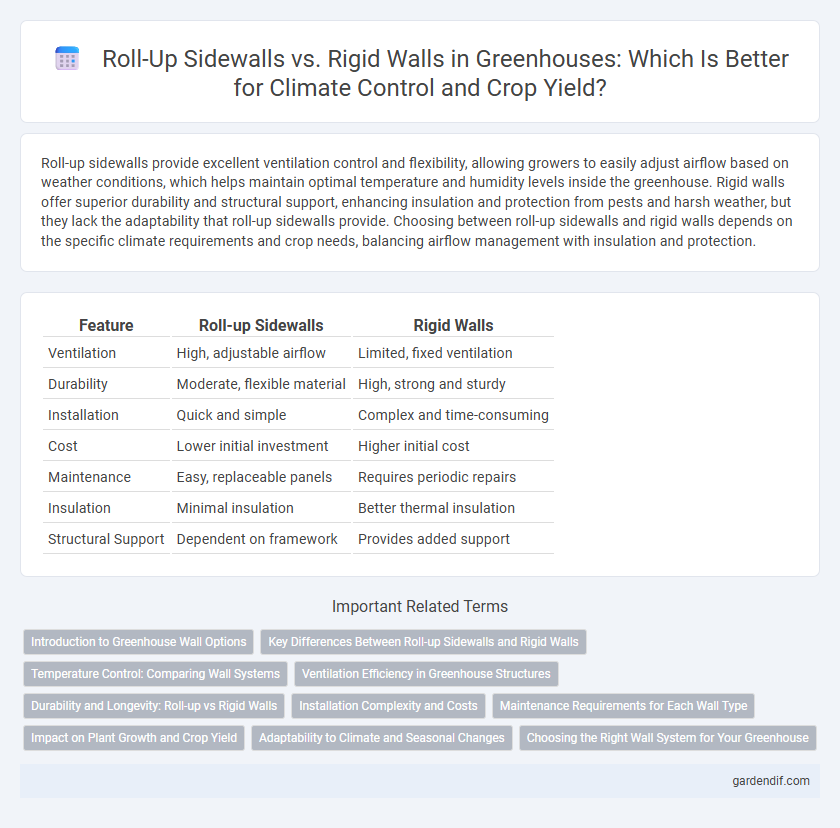
Roll-up Sidewalls vs Rigid Walls Illustration
Roll-up sidewalls provide excellent ventilation control and flexibility, allowing growers to easily adjust airflow based on weather conditions, which helps maintain optimal temperature and humidity levels inside the greenhouse. Rigid walls offer superior durability and structural support, enhancing insulation and protection from pests and harsh weather, but they lack the adaptability that roll-up sidewalls provide. Choosing between roll-up sidewalls and rigid walls depends on the specific climate requirements and crop needs, balancing airflow management with insulation and protection.
Table of Comparison
| Feature | Roll-up Sidewalls | Rigid Walls |
|---|---|---|
| Ventilation | High, adjustable airflow | Limited, fixed ventilation |
| Durability | Moderate, flexible material | High, strong and sturdy |
| Installation | Quick and simple | Complex and time-consuming |
| Cost | Lower initial investment | Higher initial cost |
| Maintenance | Easy, replaceable panels | Requires periodic repairs |
| Insulation | Minimal insulation | Better thermal insulation |
| Structural Support | Dependent on framework | Provides added support |
Introduction to Greenhouse Wall Options
Greenhouse wall options significantly impact climate control, durability, and light diffusion. Roll-up sidewalls offer flexible ventilation by allowing adjustable airflow, which is ideal for managing temperature and humidity in varying weather conditions. Rigid walls, often made of materials like polycarbonate or glass, provide enhanced insulation and structural stability, making them suitable for maintaining consistent internal environments and protecting crops from external elements.
Key Differences Between Roll-up Sidewalls and Rigid Walls
Roll-up sidewalls provide flexible ventilation control by allowing growers to adjust airflow quickly, promoting optimal temperature and humidity levels inside the greenhouse. Rigid walls offer superior structural stability and insulation, enhancing energy efficiency and protecting crops from external environmental factors. While roll-up sidewalls prioritize adaptability and natural airflow, rigid walls focus on long-term durability and climate control precision.
Temperature Control: Comparing Wall Systems
Roll-up sidewalls provide superior ventilation by allowing adjustable airflow, which helps regulate temperature fluctuations effectively in greenhouses. Rigid walls, typically constructed from materials like polycarbonate or glass, offer better insulation but can trap heat, leading to higher internal temperatures during sunny periods. Selecting between roll-up sidewalls and rigid walls depends on climate conditions and the level of temperature control needed for specific greenhouse crops.
Ventilation Efficiency in Greenhouse Structures
Roll-up sidewalls in greenhouse structures provide superior ventilation efficiency by allowing adjustable airflow, which helps regulate temperature and humidity more dynamically compared to rigid walls. Rigid walls limit natural air circulation, often requiring additional mechanical ventilation systems that increase energy consumption. Optimizing ventilation with roll-up sidewalls can improve plant growth conditions and reduce operational costs in controlled environment agriculture.
Durability and Longevity: Roll-up vs Rigid Walls
Roll-up sidewalls, typically made from flexible polyethylene or vinyl, offer moderate durability with resistance to wind and weather but may require more frequent replacement due to material wear and UV degradation. Rigid walls, composed of materials like polycarbonate or glass, provide superior longevity with enhanced structural strength, resistance to impact, and better insulation properties, significantly reducing maintenance needs over time. The choice between roll-up and rigid walls impacts greenhouse lifespan and operational costs, where rigid walls often deliver greater durability and long-term value.
Installation Complexity and Costs
Roll-up sidewalls offer simpler installation with flexible framing options, reducing labor time and upfront costs compared to rigid walls that require precise measurements and sturdy foundations. The modular nature of roll-up systems allows for quicker adjustments and maintenance, lowering long-term expenses, while rigid walls demand more substantial materials and professional installation, increasing overall project budgets. Cost efficiency in roll-up sidewalls makes them ideal for growers seeking adaptability and budget control without compromising greenhouse climate management.
Maintenance Requirements for Each Wall Type
Roll-up sidewalls require frequent inspection and lubrication of hinges and tracks to ensure smooth operation and prevent wear from exposure to weather conditions. Rigid walls demand less routine maintenance but may need periodic checks for cracks, seal integrity, and cleaning to avoid mold buildup and ensure optimal insulation. Both wall types benefit from seasonal maintenance schedules tailored to the greenhouse's climate zone to maximize durability and energy efficiency.
Impact on Plant Growth and Crop Yield
Roll-up sidewalls enhance ventilation and temperature regulation inside greenhouses, promoting optimal photosynthesis and reducing humidity-related diseases, which positively impacts plant growth and crop yield. Rigid walls offer better structural stability and insulation, maintaining consistent internal conditions that support steady growth but may limit airflow, potentially increasing heat stress during hot periods. Choosing between roll-up sidewalls and rigid walls depends on balancing ventilation needs and insulation to maximize crop productivity in specific climate conditions.
Adaptability to Climate and Seasonal Changes
Roll-up sidewalls in greenhouses offer superior adaptability to climate and seasonal changes by allowing dynamic ventilation control, which helps regulate temperature and humidity effectively during warmer months. In contrast, rigid walls provide better insulation and structural stability for colder periods but lack the flexibility to adjust airflow quickly. Selecting between roll-up sidewalls and rigid walls depends on balancing the need for environmental control with the local climate's variability and crop requirements.
Choosing the Right Wall System for Your Greenhouse
Selecting the right wall system for your greenhouse depends on factors such as climate control, durability, and ventilation needs. Roll-up sidewalls offer flexible ventilation and cost-effective temperature regulation, ideal for moderate climates and seasonal use. Rigid walls provide superior insulation, structural strength, and protection against harsh weather, making them suitable for year-round growing and more extreme environments.
Roll-up Sidewalls vs Rigid Walls Infographic

 gardendif.com
gardendif.com